The Second Largest feline in North America
Advertisement
Cougar Scientific Classification
- Kingdom
- Animalia
- Phylum
- Chordata
- Class
- Mammalia
- Order
- Carnivora
- Family
- Felidae
- Genus
- Puma
- Scientific Name
- Felis Concolor
Read our Complete Guide to Classification of Animals.
Cougar Conservation Status
Cougar Facts
- Main Prey
- Deer, Elk, Beavers
- Distinctive Feature
- Powerful forearms and paws and muscular jaw
- Habitat
- Forest and mountainous regions
- Diet
- Carnivore
- Average Litter Size
- 3
View all of the Cougar images!
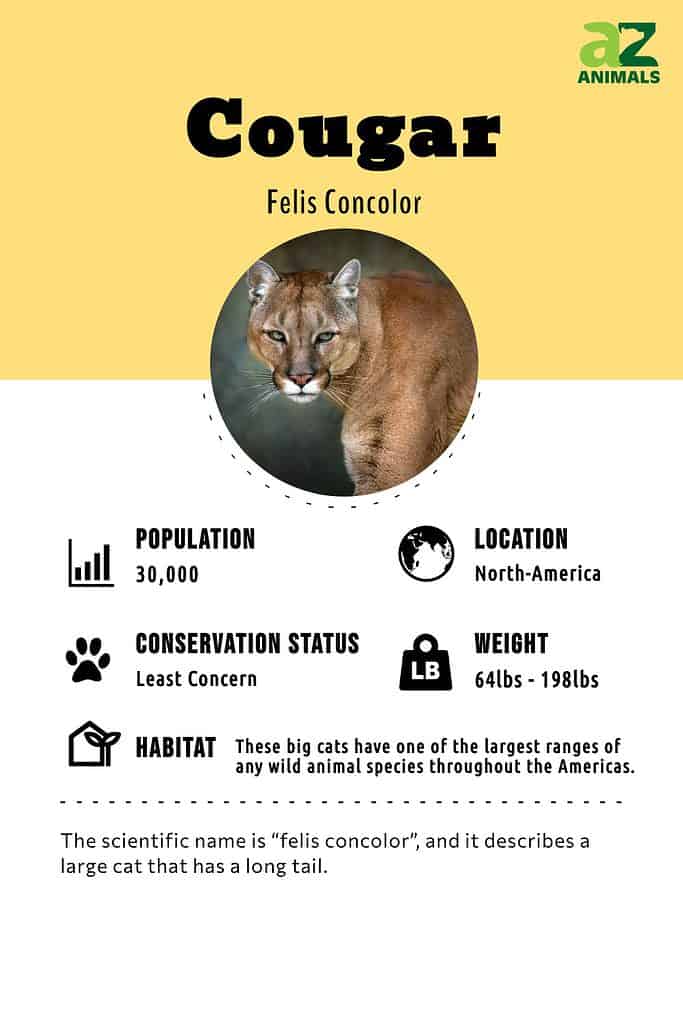
“A Big Cat Without a Roar”
As North America’s second largest cat, the cougar is an intimidating animal to run into. The cougar is unable to roar because it doesn’t have the needed larynx to do so. Instead, the big cat purrs, growls, hisses, and screams as well as whistles and chirps.
Cougars are also called pumas, panthers, and mountain lions. The cats have round heads, pointed ears, and slender bodies.
Cougar Top Facts
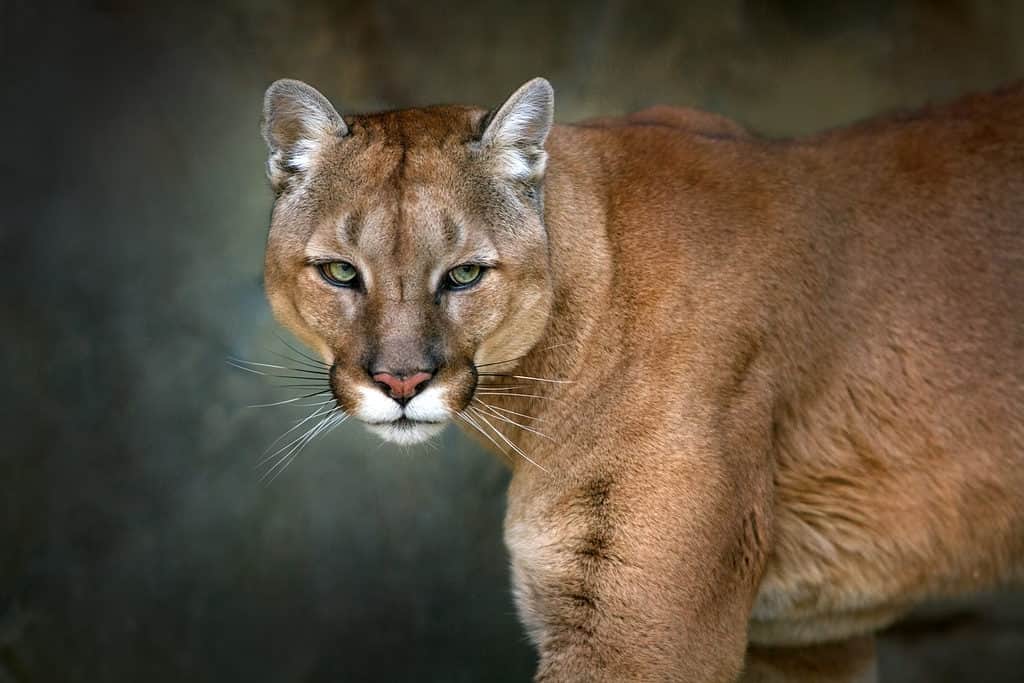
Cougars are superior hunters and are solitary animals
©Kwadrat/Shutterstock.com
• Cougars are superior hunters
• Cougars are animals that are found in many parts of the world
• Cougars dine on animals like deer, raccoons, and even crocodiles
• Like most felines, cougars are solitary animals
You can check out more incredible facts about cougars.
Scientific Name
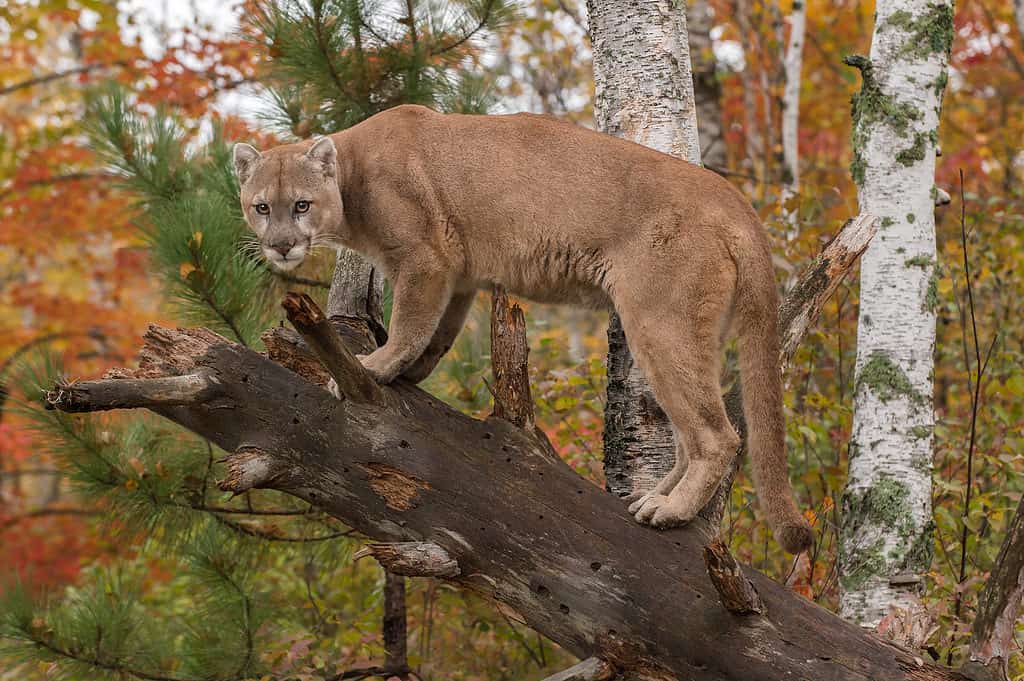
The cougar is known by the scientific name “
puma concolor” or
“felis concolor.”
©Geoffrey Kuchera/Shutterstock.com
The cougar is known by the scientific name “puma concolor” or “felis concolor.” Carl Linnaeus proposed the name “felis concolor” to describe a big cat that has a long tail. The animal has more names in the dictionary than any other animal. Along with mountain lion and puma, the cat is also called catamount and red tiger among others.
Cougars belong to the subfamily Felinae. After Linnaeus introduced a scientific description of cougars, researchers listed 32 zoological subspecies until the late ‘80s. According to genetic studies, many of the subspecies were too close to be considered separate. Now, scientists have determined that there are six phylogeographic groups.
Appearance
A cougar’s body is similar to that of a house cat on a larger scale. Mountain lion coats are a grayish tan to a reddish hue, and the animal features lighter parts underneath. The end of a cougar’s tail is black, and the cat has black markings on its ears and face.
An amazing fact about cougars is that they can jump 20 feet into the air. This allows them to pounce on prey that’s 20 feet to 40 feet away from a standing position. Learn more about the highest jumping animals in the world here.
Pumas range from 5 feet to 9 feet in length from head to tail with male cougars weighing as much as 150 pounds and females topping out at about 100 pounds.
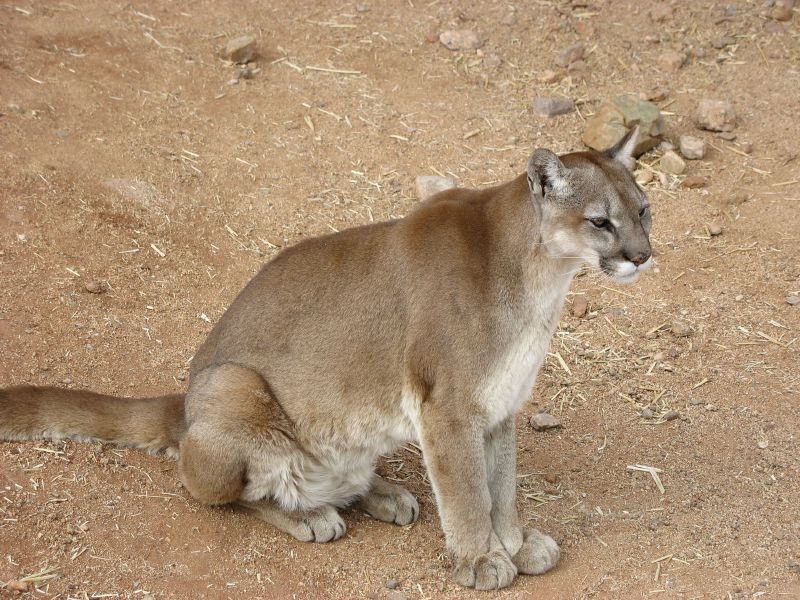
Behavior
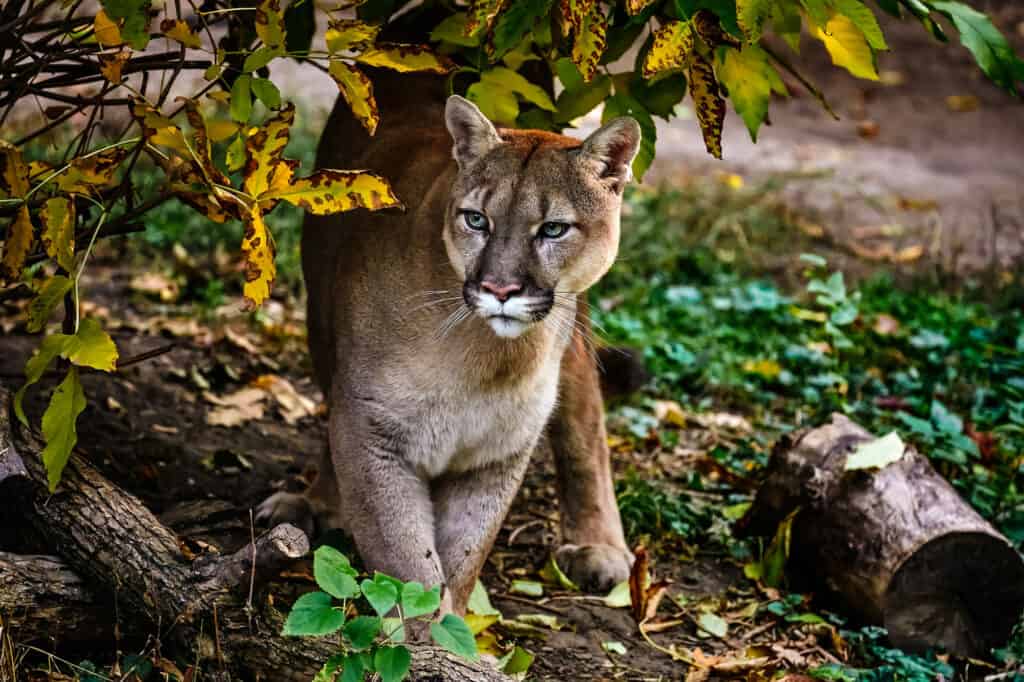
Cougars are only social when raising cubs
©Evgeniyqw/Shutterstock.com
Mountain lions are solitary animals unless a mother cougar is raising cubs. On occasion, the animals will share kills with one another. They establish themselves in small communities based around the territories of strong male cougars. Cats that live within these areas socialize with one another more often than animals that are outside of them.
Habitat

Cougars can be found in Canada’s northern Yukon to the southern Andes.
©DaryaU/Shutterstock.com
These big cats have one of the largest ranges of any wild animal species throughout the Americas. You’ll find them from Canada’s northern Yukon to the southern Andes. The animal is able to adapt to a variety of habitats including forests, mountainous deserts, and lowland areas.
Cougars prefer to live in parts of the country that feature steep canyons, rim rocks, and dense brush for protection. However, they can survive well in open areas that have very little vegetation.
Evolution and Origin
Cougars evolved from a common ancestor alongside the African cheetah and American jaguarundi, the oldest known fossil records discover. Cougars actually originated in North America and are believed to have been extirpated during the Pleistocene extinction.
What Do Cougars Eat?
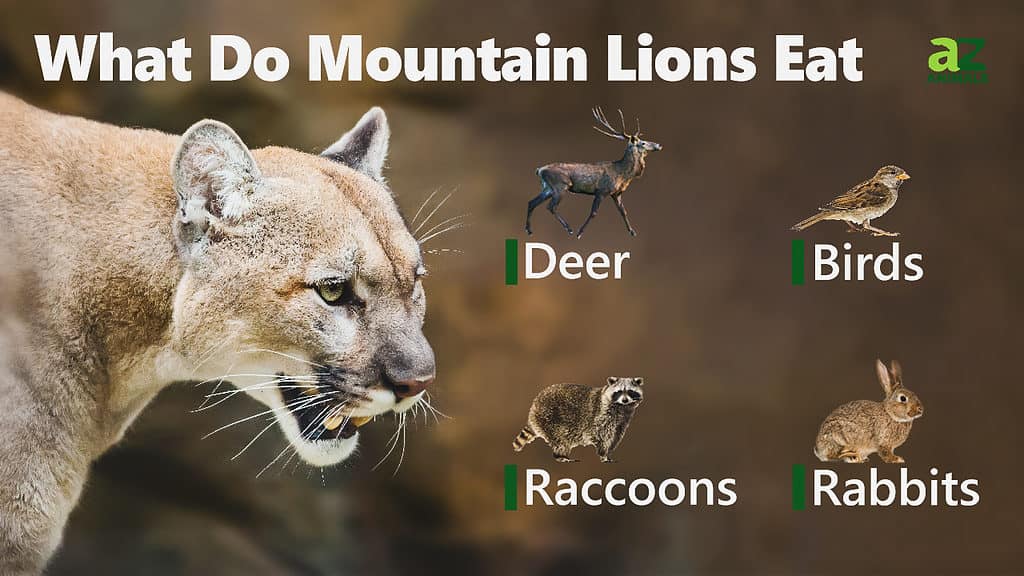
These big cats aren’t picky about their diets. They’ll dine on insects, mice, beavers, raccoons, rabbits, and wild turkeys. Since cougars live in Patagonia’s Monte Leon National Park, they’ve become quite skilled at hunting penguins.
Those that live in Florida sometimes make a meal out of a crocodile. In North America, cougars frequently eat deer. In fact, they typically kill one large deer every two weeks. These large felines are not generally scavengers, but if a deer carcass has been left exposed, then they may eat it, meaning that the cats sometimes display resourceful behavior.
Because of their powerful hind legs, cougars are ambush predators. They are hunters that stalk their victims through brush and trees before leaping powerfully onto them, delivering a deadly neck bite. The animal is able to break the neck of its prey with one strong bite and the force of driving its prey to the earth.
Predators

Human growth and population are the biggest predators for cougars
©Everett Collection/Shutterstock.com
Humans are the biggest predators of cougars with people hunting them for sport and to protect livestock. People are also the main cause of the cats losing their habitats. In states like Florida, highways are often deadly to cougars.
Out in the wild, wolf packs will prey on the cats because they’re able to surround the animal and overwhelm it with numbers. When it comes to a one-on-one battle, the cougar will usually survive the match. Wolves are more likely to affect cougars by dominating the same territory and taking advantage of prey opportunities. Wolves can also disrupt the cougar’s ability to reproduce.
The feline is not on the endangered species list, but conservation groups remain unsure about how well the cougar population is doing around the world. In the United States, the only state that prohibits hunting them is California. However, it is illegal to hunt them in Costa Rica, Guatemala, Venezuela, Brazil, and most of Argentina. To hunt the big cat in the U.S., hunters must obtain a permit unless they live in Texas.
Poachers target cougars, but the effects of this action on the cat are unknown. The U.S. Fish and Wildlife Service reports that the illegal animal part trade is a $200 million a year market, and it’s growing.
About Cougar Reproduction
Male and female mountain lions reach sexual maturity at 24 months, but according to research, females have mated as young as 20 months. The age at which a cougar first breeds often depends upon her establishing a home range. A major breeding challenge that cougars face is finding each other due to their solitary lifestyle. The cats are usually scattered across hundreds of miles of rough terrain.
Another reproduction complication is that female cougar are only interested in mating for several days out of a month. Despite the challenges, the animals find a way to breed. They have keen senses and practice polygamy.
When cougars breed, they do so vigorously by copulating at a rate of 50 times to 70 times within a 24-hour period for 7 to 8 days. Each time a couple copulates, it lasts less than a minute. Because the felines are so vigorous, researchers believe that the act stimulates ovulation, which is when the ovaries release an egg so that it can be fertilized.
Cougar Cubs
Once a female cougar conceives, after 88 to 96 days, she will retire to the privacy of a den and give birth to a litter of cubs. Cougar litters vary in size from one to six cubs with the average size being two to three kittens. A young female cougar may only have one cub for her first litter. Researchers believe that this gives young females time to develop their mothering skills.
Cougars generally bear young every other year, which means that a female mountain lion that lives for 8 to 10 years may be able to produce five litters. According to reports, one mother cougar in captivity produced seven litters in 16 years.
Baby cougars usually weigh slightly more than 1 pound when they are born. Within 10 to 20 days, they grow to double their weight, and by the time they reach 2 months of age, they can weigh as much as 9 pounds.
When cougar babies are born, their coats typically have black spots, which camouflage them, protecting the juveniles from predators. The spots generally last for about 6 months. Baby cubs are born deaf, blind, and almost immobile, making them vulnerable to predators. To gain strength and learn how to take down their prey, cougar cubs play and pounce on one another.
Mother cougars start taking their cubs to kill when they reach 7 to 8 weeks of age. The female will also take the meat to her babies until she weans them when they’re 2 to 3 months old. As the cubs grow, the female will leave them at a kill site for several days at a time while she hunts for their next meal. Mother cougars will travel further in search of food as their cubs become older and stronger.
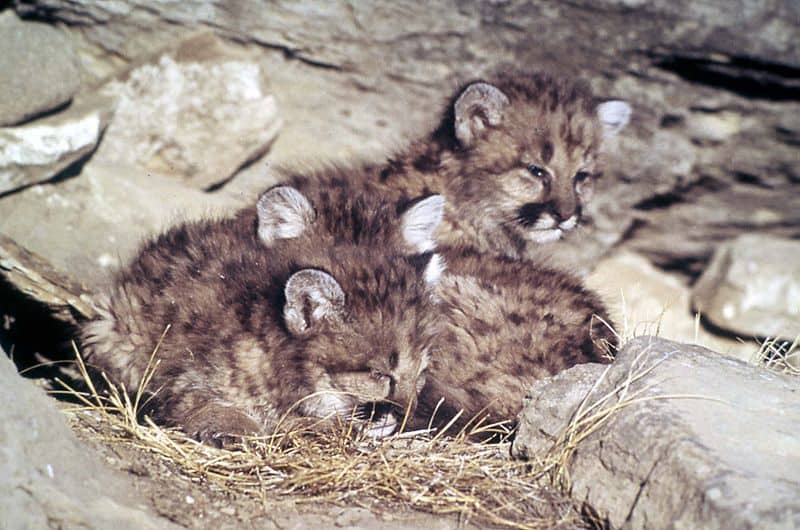
Lifespan
When a cougar is in captivity, the animal can live for as long as 20 years. However, there is a report of one captive cougar that lived to be 29. In the wild, their lifespan is about half that. Researchers disagree about which sex lives longer. Some say that females live for fewer years due to the stress of having and raising cubs.
Even when humans are not threatening them, cougars tend to have a high-risk lifestyle. They are frequently exposed to injury or death because they target animals that are larger than themselves.
When they are attacking elk or deer, they may be thrown against a tree or a rock hard enough to break their backs. Sometimes, they are trampled by the hooves of herd animals. Cougars can be impaled by a branch or an antler, and an injury like this may result in starvation. The cats die from lightning strikes, poisonous snake bites, and rock slides.
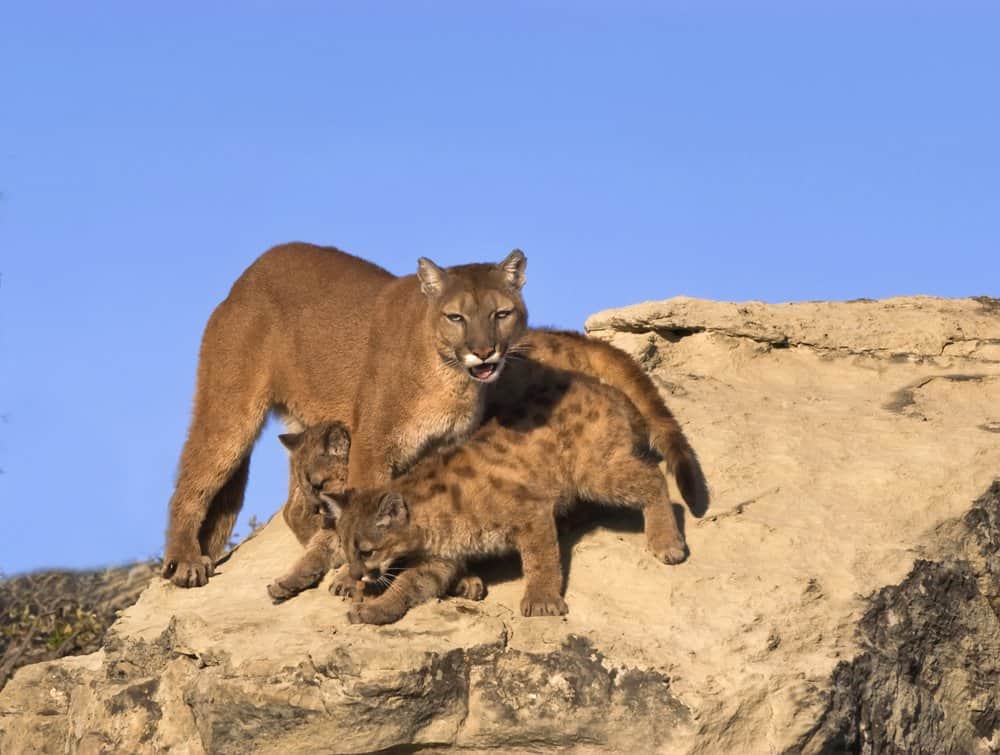
When a cougar is in captivity, the animal can live for as long as 20 years.
©outdoorsman/Shutterstock.com
Population
Researchers have been unable to provide an exact estimate regarding how many cougars are in the wild. Some believe that there are an estimated 30,000 of them throughout the American west.
The density of cougars generally ranges from one to seven cats for every 100 kilometers of territory with males permitting several females to be present in their ranges. Oregon estimates that its cougar population is around 6,600 while California believes that it has between 4,000 and 6,000 animals.
The International Union for Conservation of Nature, which tracks the cougar population in each Central and South American country, reports that there are less than 50,000 of the big cats populating that part of the world. This is thought to be a declining trend.
However, cougar researchers in the U.S. believe that the country’s population is rebounding. California has protections in place for its cougar population, but thirteen states including Wyoming, Colorado, and Utah classify them as a game species, allowing people to hunt them for sport.
View all 235 animals that start with CCougar FAQs (Frequently Asked Questions)
Is the Cougar an Herbivore, an Omnivore or a Carnivore?
The cougar animal is an obligate carnivore. This means that to survive, the animal must feed on meat. The feline is a generalist predator, so it will make a meal of any animal that it is able to catch. While it prefers to eat hoofed animals like deer, elk and moose, the feline will eat feral hogs, coyotes and badgers.
Are Cougars Dangerous to Humans?
Cougars attack humans, but fatal attacks are rare. Humans are much more dangerous to cougars. More cougar attacks are happening across the United States due to human development making its way into the habitat of the felines. This is also causing cougar populations to drop. Children are more vulnerable to cougar attacks than adults with children making up 64% of the total victims. People who are in cougar territory alone are at a higher risk of being attacked than those who move through these areas in groups.
Is There a Difference Between a Cougar and a Mountain Lion?
There is no difference between a cougar and a mountain lion. This large cat has so many names because it is found in many different parts of the country and the world. Early North and South American explorers referred to the cat as leon, or lion, and gato monte, which means cat of the mountain. This is how the name “mountain lion” was given to the feline. The name “cougar” appears to be from an old South American word cuguacuarana, and this was shortened to the word “cuguar” and later, it received the “cougar” spelling.
What Kingdom do Cougars belong to?
Cougars belong to the Kingdom Animalia.
What phylum do Cougars belong to?
Cougars belong to the phylum Chordata.
What class do Cougars belong to?
Cougars belong to the class Mammalia.
What family do Cougars belong to?
Cougars belong to the family Felidae.
What order do Cougars belong to?
Cougars belong to the order Carnivora.
What genus do Cougars belong to?
Cougars belong to the genus Puma.
What type of covering do Cougars have?
Cougars are covered in Fur.
In what type of habitat do Cougars live?
Cougars live in forests and mountainous regions.
What is the main prey for Cougars?
Cougars prey on deer, elk, and beavers.
What are some predators of Cougars?
Predators of Cougars include humans and grizzly bears.
What are some distinguishing features of Cougars?
Cougars have powerful forearms and paws and muscular jaws.
How many babies do Cougars have?
The average number of babies a Cougar has is 3.
What is an interesting fact about Cougars?
Cougars are the largest feline in North America.
What is the scientific name for the Cougar?
The scientific name for the Cougar is Felis Concolor.
What is the lifespan of a Cougar?
Cougars can live for 10 to 20 years.
How fast is a Cougar?
A Cougar can travel at speeds of up to 30 miles per hour.
How to say Cougar in ...
Thank you for reading! Have some feedback for us? Contact the AZ Animals editorial team.
Sources
- David Burnie, Dorling Kindersley (2011) Animal, The Definitive Visual Guide To The World's Wildlife / Accessed November 10, 2008
- Tom Jackson, Lorenz Books (2007) The World Encyclopedia Of Animals / Accessed November 10, 2008
- David Burnie, Kingfisher (2011) The Kingfisher Animal Encyclopedia / Accessed November 10, 2008
- Richard Mackay, University of California Press (2009) The Atlas Of Endangered Species / Accessed November 10, 2008
- David Burnie, Dorling Kindersley (2008) Illustrated Encyclopedia Of Animals / Accessed November 10, 2008
- Dorling Kindersley (2006) Dorling Kindersley Encyclopedia Of Animals / Accessed November 10, 2008
- David W. Macdonald, Oxford University Press (2010) The Encyclopedia Of Mammals / Accessed November 10, 2008


















